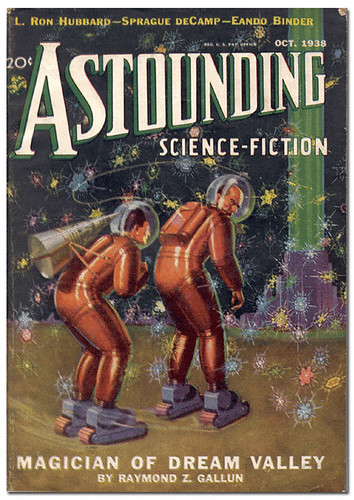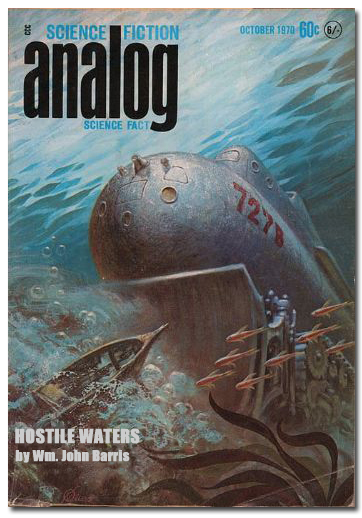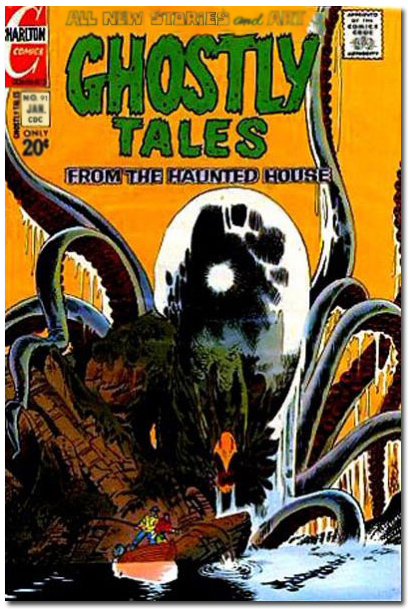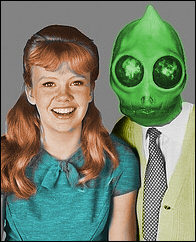 Science Fiction authors are often lauded for their prescience in predicting the future of technology and society. What is not often remembered though is that SF authors have about the same rate of success in predicting the future as the average psychic. That is, if one makes enough guesses eventually one will be spot on. The difference between a psychic and a science fiction author being of course that the writer usually doesn't receive $700 an hour for making stuff up.
Science Fiction authors are often lauded for their prescience in predicting the future of technology and society. What is not often remembered though is that SF authors have about the same rate of success in predicting the future as the average psychic. That is, if one makes enough guesses eventually one will be spot on. The difference between a psychic and a science fiction author being of course that the writer usually doesn't receive $700 an hour for making stuff up.
One of those authors who made an educated guess and created a concept many are familiar with today was William John Barris. As far as I can tell Barris was one of those writers that didn't work exclusively in Science Fiction as I can find only one credited work bearing his name. Full bibliographies in pulps works and magazines are sometimes lacking and it may be that Barris was quite prolific in the era. Writers often went uncredited or worked under a house pseudonym for different publishers. Then again, he may have been a one-shot writer and this is his only work.
But what a work it was.
Hostile Waters was a short story originally published in the October 1938 issue of Astounding Science Fiction. The story chronicles the changes wrought upon the world when nature rebels against humanity. Hostile Waters is cautionary tale of the environment long before it became vogue to do so in pop culture. The plot of the story was typical of the works of that era. A serious problem, possibly extraterrestrial, is presented that holds the threat of destroying all life on the planet until a lone scientist discovers the method that saves the day. This premise is one of the thematic underpinnings of most pulp stories that were carried virtually unchanged into the comic book genre.
But it wasn't the story-telling skill of the author (or lack thereof) or the prose given editorial limitations that is most interesting. What is worth noting is exactly what it was that Barris introduced to readers in his tale. As described by Barris one of the most basic elements required to sustain life on earth, that of water, attacks humanity without mercy. As Barris wrote:
"Any sufficiently large volume of water would become inimically motile. A person could drink from a pump or perambulate in summer showers or bathe and in that manner much of civilization proceeded as before, blissful and caring none. Rivers, lakes and oceans were no moreIn short order the protagonist of the tale became curious as to why only humans and not lower orders of land animals such as cows and aquatic life such as whales and fish were attacked. Risking death to procure a large tank of "hostile water" the scientist discovered that the sample was infested with uncounted "tiny clockworks, joined as chains and fetters". The scientist realized that minuscule machines were in control of all the molecules of water and were programmed to assault humanity. So it was that in what may have been his only credited published work Barris effectively predicted nanotechnology decades before it would begin to receive attention in scientific journals and fiction.a frontier of commerce and exploration. In a fortnight mighty warships that feared no country's navy or condition of inclement weather vanished into the deep as the favored coasts were riven by waves and scoured sterile. The farmer's pond was a thing to approach with caution or flee outright. To a man we fled before the wrath of God's broken promise and sought refuge in the hills and deserts and prayed for drought."
 The story, forgotten for years was at least held in some regard by a few editors, namely Harold Oakes of Analog. On each occasion Hostile Waters was reprinted in science fiction magazines it was when Oakes was an editor. The story even received cover attention. Of the two reprintings the May 1958 cover of Astounding has the most egregious disconnect to the story. The aquatic warriors are not featured in the story in any form. Covers wildly disparate from the featured story is another element that successfully made the transition in the evolution of pulps to comic books.
The story, forgotten for years was at least held in some regard by a few editors, namely Harold Oakes of Analog. On each occasion Hostile Waters was reprinted in science fiction magazines it was when Oakes was an editor. The story even received cover attention. Of the two reprintings the May 1958 cover of Astounding has the most egregious disconnect to the story. The aquatic warriors are not featured in the story in any form. Covers wildly disparate from the featured story is another element that successfully made the transition in the evolution of pulps to comic books.The next and last printing in the August 1970 Analog would feature a much more accurate representation of the story, though the technology in the deep sea exploration vessel was admittedly updated for the cover art to be contemporary to 1970.
The story would once more show up in a radically altered form as a throw away comic book story in an early 1970s Charlton horror comic book anthology. All of the science fiction elements are gone from what is clearly a ripped-off plot. The names of the
 doomed lovers on a lake remain intact and enough of the scene is similar to the original Hostile Waters story to lend me to extrapolate that some unknown staff member at Charlton had a subscription to Analog in 1970.
doomed lovers on a lake remain intact and enough of the scene is similar to the original Hostile Waters story to lend me to extrapolate that some unknown staff member at Charlton had a subscription to Analog in 1970.For such an obscure author Wm. John Barris had an amazing life in print from his one mostly forgotten effort. In my reading of decades of pulp work that were reprinted into the 1970s for new and appreciative audiences one of the secrets to the Barris story surviving and having the occasional revival when other authors remained lost in obscurity was not so much the introduction of nanotech or skill in authorship.
What Hostile Waters has in common with stories from the same era that enjoy a new life in reprints is that the detailed descriptions of technology and society in the stories are left vague either through design or from lazy writing. Steam-punk and the world of H. G. Wells have their place but when seeking low-cost inventory stories to fill pages in an an anthology title an editor would undoubtedly choose those works that can be read by contemporary readers and still be compatible with readers and allow for the required suspension of disbelief.
Tags: Pulps Creative Writing Nanotechnology



























Fantastic post!
ReplyDelete"The difference between a psychic and a science fiction author being of course that the writer usually doesn't receive $700 an hour for making stuff up."
ReplyDeleteReminds me of a discussion I had with a "believer" at a party.
They: Really they (psychics) are just doing their best to help others. But they have to charge to earn a living too.
Me: Well, if their powers are real. Predict a winning lottery number. Live off the winnings and do their readings as free public service.
They: A reputable psychic would never abuse their powers that way.
Then I pointed them to the "dip" so they could be with their own kind.
*sigh*
On the main topic, I know I read this story somewhere. I wish I remember what anthology, but I remember it being fun and I definitely want to read it again.
Wait a second, have you seen this?
ReplyDeletehttp://www.apple.com/trailers/independent/thelastwinter/trailer/
This is a genre that has been bubbling under the surface for a long time (killer bees, giant sewer crocodiles; they're all part of the long tradition). But "The Day After Tomorrow" showed there was some money to be made (albeit cheesily, perhaps).
Now about that meteor that made everyone sick in Peru...
"Clockworks joined in chains and fetters", wow, what a charming turn of phrase.
ReplyDelete